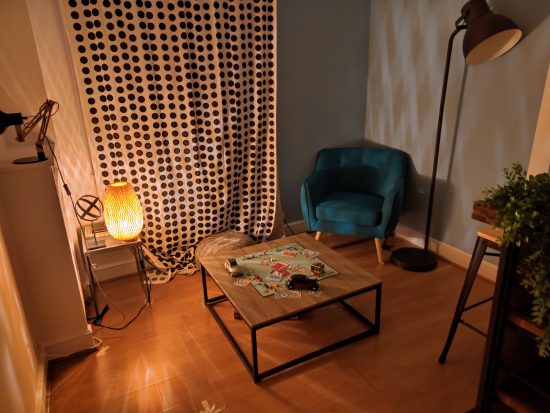The Vivo X60 Pro+ 5G marks the top of the line in the Chinese manufacturer’s X60 flagship smartphone line. Specifications include a 6.56-inch FHD+ AMOLED display with 120 Hz refresh rate, the latest Snapdragon 888 chipset with 12 GB + 3 GB virtual RAM, and a 4200 mAh battery with fast 55W wired charging.
The camera has been co-engineered with the legendary optics company Zeiss and packs four sensors on the rear, including a 50 MP main camera, a 48 MP ultra-wide, and two tele-lens modules. The tele options include a 50 mm-equivalent portrait lens and a 125 mm-equivalent periscope-style lens for longer zoom shots.
Key camera specifications:
- Primary: 50 MP 1/1.3-inch GN1 sensor, 23 mm-equivalent f/1.57-aperture lens
- Ultra-wide: 48 MP ultra-wide gimbal camera; 114° field-of-view, 14 mm-equivalent f/2.2-aperture lens
- Tele 1: 32 MP sensor, 50 mm-equivalent f/2.08 lens
- Tele 2: 8 MP sensor, 125 mm-equivalent f/3.4-aperture lens
- 4320p/30 fps, 2160p/60 fps, 1080p/60 fps video
- VIS 5-axis video stabilization, HDR 10+ video recording
About DXOMARK Camera tests: For scoring and analysis in our smartphone camera reviews, DXOMARK engineers capture and evaluate over 3000 test images and more than 2.5 hours of video both in controlled lab environments and in natural indoor and outdoor scenes, using the camera’s default settings. This article is designed to highlight the most important results of our testing. For more information about the DXOMARK Camera test protocol, click here. More details on how we score smartphone cameras are available here.
Test summary
Scoring
Sub-scores and attributes included in the calculations of the global score.

Vivo X60 Pro+


Use cases & Conditions
Use case scores indicate the product performance in specific situations. They are not included in the overall score calculations.
Outdoor
Photos & videos shot in bright light conditions (≥1000 lux)
Indoor
Photos & videos shot in good lighting conditions (≥100lux)
Lowlight
Photos & videos shot in low lighting conditions (<100 lux)
Friends & Family
Portrait and group photo & videos
Pros
- Good detail in photos and videos
- Wide dynamic range in most photos
- Accurate white balance in most photos and videos
- Video target exposure mostly accurate
- Well-controlled artifacts and very little corner softness on ultra-wide camera
Cons
- Exposure instabilities in photo and video mode
- Visible noise in many photos and videos
- Some autofocus failures, especially in low-light photos
- Multiple artifacts visible in photos and videos
With an overall score of 128, the Vivo X60 Pro+ 5G just makes it into the current top ten in our DXOMARK Camera ranking, only a few points behind such heavy hitters as the Huawei Mate 40 Pro+ at 139 and Xiaomi Mi 10 Ultra at 133.
The Vivo X60 Pro+ 5G camera captures excellent pictures in a wide range of lighting conditions; good exposure, wide dynamic range, accurate white balance, and high detail are all note-worthy attributes. Its Photo score of 131 is very good, but some problems with exposure instability, visible noise, and autofocus failures prevented it from scoring higher.
In the Zoom department, the dual tele-modules (together with an ultra-wide) ensured that the Vivo X60 Pro+ 5G achieved a solid 84. While tele-lens shots are very acceptable at all distances, the X60 Pro+ 5G’s tele score of 107 isn’t quite as good as previous dual-telephoto lens devices we’ve tested, such as the Huawei Mate 40 Pro+ and the Xiaomi Mi 10 Ultra, due to a lack of detail at long range as well as quite significant autofocus and exposure instabilities.
The Photo and Zoom issues mentioned above also prevented the Vivo X60 Pro+ 5G from scoring higher than its predecessor, the Vivo X50 Pro+.
With a Video score of 110, the device offers a very good experience when shooting movies. Great detail in outdoor and indoor movies and nice color rendering with accurate white balance ensures that most videos really pop. Noise gets a little high in low-light conditions, but if you seek out some fairly decent lighting, you’ll be impressed with the Vivo’s video capabilities.
Below you can find a detailed analysis and image samples for all Photo, Zoom, and Video sub-attributes, as well as comparisons with two of the Vivo X60 Pro+ 5G’s competitors, the Huawei Mate 40 Pro+ and the Xiaomi Mi 10 Ultra.
Photo
The Vivo X60 Pro+ 5G achieves a Photo score of 131. In this section, we take a closer look at each sub-attribute and compare image quality against competitors.

Exposure and Contrast
Vivo X60 Pro+
105
111
In these tests we analyze target exposure, contrast, and dynamic range, including repeatability across a series of images. Tests are undertaken in a wide range of light conditions, including backlit scenes and low light down to 1 lux. The score is derived from a number of objective measurements in the lab and perceptual analysis of real-life images.
These samples show the Vivo X60 Pro+ 5G’s exposure performance in a backlit indoor scene compared to the competition.

Color
Vivo X60 Pro+
101
107
In these tests we analyze color rendering, skin tones, white balance, and color shading, including repeatability across a series of images. The score is derived from a number of objective measurements in the lab and perceptual analysis of real-life images.
These samples show the Vivo X60 Pro+ 5G’s color performance in low light compared to the competition.

Autofocus
Vivo X60 Pro+
84
109
In these tests we analyze autofocus accuracy and shooting time, including repeatability, in the lab. We test focus failures, depth of field, and tracking of moving subjects using perceptual analysis of real-life images.
This graph shows the Vivo X60 Pro+ 5G’s autofocus performance when handheld in the lab at a light level of 20 lux.
In these tests we analyze texture on faces and objects, including objects in motion, in a range of light conditions, using several lab test setups and perceptual analysis of real-life images.
These samples show the Vivo X60 Pro+ 5G’s texture performance in outdoor light compared to the competition.

Noise
Vivo X60 Pro+
82
102
In these tests we analyze noise on faces and objects, including objects in motion, in a range of light conditions, using several lab test setups and perceptual analysis of real-life images.
These samples show the Vivo X60 Pro+ 5G’s noise performance in low light compared to the competition.
For these tests we switch to the camera’s bokeh or portrait mode and analyze depth estimation, bokeh shape, blur gradient, and repeatability, as well as all other general image quality attributes mentioned above. The score is derived from perceptual analysis of real-life images.
These samples show the Vivo X60 Pro+ 5G’s bokeh simulation in daylight compared to the competition.


Night
Vivo X60 Pro+
67
82
In these tests we shoot a selection of images in pitch-black darkness as well as with city lights in the background providing some illumination. We shoot sample images with the camera at default settings in both flash-auto and flash-off modes. We analyze all image quality attributes but we pay particular attention to exposure, autofocus, and color. We do not test night modes that have to be activated manually.
These samples show the Vivo X60 Pro+ 5G’s night performance in flash-off mode compared to the competition.

Artifacts
Vivo X60 Pro+
62
77
In these tests we check images for optical artifacts such as vignetting, flare, lens softness in the corner, distortion, and chromatic aberrations, as well as for processing artifacts such as ghosting and fusion errors, hue shift, and ringing.
This sample shows ringing, color fringing, and color quantization artifacts in an outdoor image.

Preview
Vivo X60 Pro+
49
80
In these tests we analyze the image quality of the preview image and the differences between preview images and captured images, particularly in terms of exposure, dynamic range, and bokeh effect. We also check the smoothness of the field-of-view changes on the preview image when zooming with both buttons or when using the pinch-zoom gesture.
These samples show the Vivo X60 Pro+ 5G’s preview performance in an indoor setting.
Zoom
The Vivo X60 Pro+ 5G achieves a Zoom score of 84. The Zoom score includes the tele and wide sub-scores. In this section, we take a closer look at how these sub-scores were achieved and compare zoom image quality against competitors.

Wide
Vivo X60 Pro+
50
58
In these tests we analyze the performance of the ultra-wide camera at several focal lengths from 12 to 20 mm. We look at all image quality attributes, but we pay particular attention to such artifacts as chromatic aberrations, lens softness, and distortion.
These samples show the performance of the Vivo X60 Pro+ 5G’s ultra-wide camera in daylight conditions compared to the competition.

Tele
Vivo X60 Pro+
107
140
In these tests we analyze all image quality attributes at focal lengths from approximately 40 to 300 mm, paying particular attention to texture and detail. The score is derived from a number of objective measurements in the lab and perceptual analysis of real-life images.
These samples show the Vivo X60 Pro+ 5’’s and its competitors’ tele performance at a long-range zoom setting.
Video
The Vivo X60 Pro+ 5G achieves a Video score of 110. A device’s overall Video score is derived from its performance and results across a range of attributes in the same way as the Photo score. In this section, we take a closer look at these sub-scores and compare video image quality against competitors.
In our Video tests we analyze the same image quality attributes as for still images, such as exposure, color, texture or noise, but we also include such temporal aspects as speed, and smoothness and stability of exposure, white balance and autofocus transitions.
NOTE: The sample video clips in this section are best viewed at 4K resolution.

Exposure and Contrast
Vivo X60 Pro+
90
118
These video stills show the Vivo X60 Pro+ 5G’s video exposure in low light compared to the competition.

Color
Vivo X60 Pro+
101
107
These video stills show the Vivo X60 Pro+ 5G’s video color in outdoor light compared to the competition.

Autofocus
Vivo X60 Pro+
89
109
These sample clips show the Vivo X60 Pro+ 5G’s video autofocus performance indoors compared to the competition.

Texture
Vivo X60 Pro+
90
99
These sample clips show the Vivo X60 Pro+ 5G’s texture performance in indoor conditions compared to the competition.

Noise
Vivo X60 Pro+
87
105
This graph shows the Vivo X60 Pro+ 5G’s video spatial noise performance under different lighting conditions in the lab compared to the competition.

Artifacts
Vivo X60 Pro+
81
85
For video artifacts, we check for the same kinds of artifacts mentioned in the Photo section, along with such video-specific artifacts as frame rate variation in different light conditions, judder effect, and moving artifacts (artifacts such as aliasing, color quantization, and flare can often be more intrusive when moving than in a still image).
This video shows a hue shift near saturation in the background.

Stabilization
Vivo X60 Pro+
101
103
In these tests we analyze residual motion when handholding the camera during recording, as well as when walking and running with the camera. We also look for stabilization artifacts such as jello effect, sharpness differences between frames, and frame shift (abrupt changes of framing).
This sample clip shows the Vivo X60 Pro+ 5G’s video stabilization in outdoor conditions compared to the competition.
Xiaomi Mi 10 Ultra video, some residual motion



































DXOMARK encourages its readers to share comments on the articles. To read or post comments, Disqus cookies are required. Change your Cookies Preferences and read more about our Comment Policy.